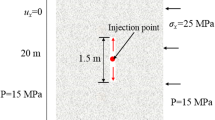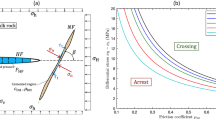Abstract
Hydraulic fracturing (HF) has been widely used in the exploitation of oil, shale gas and other resources in recent years, while phase field model (PFM) has immense potential for predicting fracture and has been increasingly applied to HF. However, current studies on combination of PFM and HF seldom consider the influence of initial stress field on hydraulic fracture prediction in naturally layered rocks, which is still a challenging topic for researchers. Therefore, a 3D phase field model for simulating quasi-static longitudinal hydraulic fracture propagation in naturally layered porous rocks subjected to stress boundary conditions is proposed. We involve the effect of initial stress field in a new energy functional and couple it to variational approach for achieving governing equations for the displacement and phase fields. The coupling of fluid pressure field and displacement field is under the framework of Biot poroelasticity and the fluid properties are validly approximately via the phase field. The phase field framework proposed is verified through two examples: 2D domain subjected to an increasing internal pressure and 3D longitudinal fracture in a homogeneous domain. Finally, PFM shows the hydraulic fracture propagation in layered rocks and explores the effects of the initial stress field, stiffness contrast, and inclination angle of the interface on fracture patterns. The proposed PFM can predict penetration, singly deflected, and doubly deflected fracture scenarios and can help guide and optimize the design of HF in naturally layered unconventional reservoirs in an elegant way.
































Similar content being viewed by others
References
Zhou S, Zhuang X, Rabczuk T (2020) Phase field method for quasi-static hydro-fracture in porous media under stress boundary condition considering the effect of initial stress field. Theoret Appl Fract Mech 107:102523
Häring MO, Schanz U, Ladner F, Dyer BC (2008) Characterisation of the Basel 1 enhanced geothermal system. Geothermics 37(5):469–495
Zhuang X, Zhou S, Sheng M, Li G (2020) On the hydraulic fracturing in naturally-layered porous media using the phase field method. Eng Geol 266:105306
Zhang Y, Chen S, Li X, Wang H (2021) Hydraulic fracturing simulation technology of shale gas reservoir and application of extended finite element method (in Chinese). Nat Gas Geosci 32(1):109–118
Shi F, Liu J (2021) A fully coupled hydromechanical xfem model for the simulation of 3d non-planar fluid-driven fracture propagation. Comput Geotech 132:103971
Jin W, Arson C (2020) Fluid-driven transition from damage to fracture in anisotropic porous media: a multi-scale xfem approach. Acta Geotech 15(1):113–144
Rabczuk T, Belytschko T (2004) Cracking particles: a simplified meshfree method for arbitrary evolving cracks. Int J Numer Meth Eng 61(13) :2316–2343
Rabczuk T, Belytschko T (2007) A three-dimensional large deformation meshfree method for arbitrary evolving cracks. Comput Methods Appl Mech Eng 196(29–30):2777–2799
Zhuang X, Augarde CE, Mathisen KM (2012) Fracture modeling using meshless methods and level sets in 3D: Framework and modeling. Int J Numer Meth Eng 92(11):969–998
Shauer N, Duarte CA (2020) A generalized finite element method for three-dimensional hydraulic fracture propagation: comparison with experiments. Eng Fract Mech 235:107098
Yan C, Wang T, Ke W, Wang G (2021) A 2d fdem-based moisture diffusion-fracture coupling model for simulating soil desiccation cracking. Acta Geotech 16(8):2609–2628
Yan C, Fan H, Huang D, Wang G (2021) A 2D mixed fracture-pore seepage model and hydromechanical coupling for fractured porous media. Acta Geotech 16(10):3061–86
Xu Y, Li X, Liu Q, Yang S, Tan X (2021) A semi-analytical solution of finite-conductivity multi-wing fractured well in naturally fractured reservoirs by boundary element method. J Pet Sci Eng 203:108584
Kwok C-Y, Duan K, Pierce M (2020) Modeling hydraulic fracturing in jointed shale formation with the use of fully coupled discrete element method. Acta Geotech 15(1):245–264
Booshehrian A, Wan R, Xueqing S (2020) Hydraulic variations in permafrost due to open-pit mining and climate change: a case study in the canadian arctic. Acta Geotech 15(4):883–905
Liao J, Gou Y, Feng W, Mehmood F, Xie Y, Hou Z (2020) Development of a full 3d numerical model to investigate the hydraulic fracture propagation under the impact of orthogonal natural fractures. Acta Geotech 15(2):279–295
Hou MZ, Li M, Gou Y, Feng W (2021) Numerical simulation and evaluation of the fracturing and tight gas production with a new dimensionless fracture conductivity (f cd) model. Acta Geotech 16(4):985–1000
Wang S, Idinger G, Wu W (2021) Centrifuge modelling of rainfall-induced slope failure in variably saturated soil. Acta Geotech 16(9):2899–916
Chau-Dinh T, Zi G, Lee P-S, Rabczuk T, Song J-H (2012) Phantom-node method for shell models with arbitrary cracks. Comput Struct 92:242–256
Rabczuk T, Zi G, Gerstenberger A, Wall WA (2008) A new crack tip element for the phantom-node method with arbitrary cohesive cracks. Int J Numer Methods Eng 75(5):577–599
Belytschko T, Lin JI (1987) A three-dimensional impact-penetration algorithm with erosion. Int J Impact Eng 5(1–4):111–127
Johnson GR, Stryk RA (1987) Eroding interface and improved tetrahedral element algorithms for high-velocity impact computations in three dimensions. Int J Impact Eng 5(1–4):411–421
Sun J, Löhnert S (2021) 3d thermo-mechanical dynamic crack propagation with the xfem and gradient enhanced damage. PAMM 20(1):e202000271
Areias P, Msekh MA, Rabczuk T (2016) Damage and fracture algorithm using the screened Poisson equation and local remeshing. Eng Fract Mech 158:116–143
Wang Y, Zhou X, Wang Y, Shou Y (2018) A 3-D conjugated bond-pair-based peridynamic formulation for initiation and propagation of cracks in brittle solids. Int J Solids Struct 134:89–115
Oterkus S, Madenci E, Oterkus E (2017) Fully coupled poroelastic peridynamic formulation for fluid-filled fractures. Eng Geol 225:19–28
Wang HY (2016) Numerical investigation of fracture spacing and sequencing effects on multiple hydraulic fracture interference and coalescence in brittle and ductile reservoir rocks. Eng Fract Mech 157:107–124
Zhou X-P, Wang Y-T (2021) State-of-the-art review on the progressive failure characteristics of geomaterials in peridynamic theory. J Eng Mech 147(1):03120001
Wang Y, Zhou X, Shou Y (2017) The modeling of crack propagation and coalescence in rocks under uniaxial compression using the novel conjugated bond-based peridynamics. Int J Mech Sci 128:614–643
Wang Y-T, Zhou X-P, Kou M-M (2019) Three-dimensional numerical study on the failure characteristics of intermittent fissures under compressive-shear loads. Acta Geotech 14(4):1161–1193
Agrawal S, York J, Foster JT, Sharma MM (2021) Coupling peridynamics with the classical methods for modeling hydraulic fracture growth in heterogeneous reservoirs. SPE J 26(05):2651–2669
Huilong, Ren Xiaoying, Zhuang Nguyen-Thoi, Trung Timon, Rabczuk (2021) A nonlocal operator method for finite deformation higher-order gradient elasticity. Comput Methods Appl Mech Eng 384:113963
Blaise B, Gilles AF, Jean-Jacques M (2008) The variational approach to fracture. J Elast 91(1–3):5–148
Miehe C, Welschinger F, Hofacker M (2010) Thermodynamically consistent phase-field models of fracture: variational principles and multi-field fe implementations. Int J Numer Method Eng 83(10):1273–1311
Miehe C, Hofacker M, Welschinger F (2010) A phase field model for rate-independent crack propagation: robust algorithmic implementation based on operator splits. Comput Methods Appl Mech Eng 199(45–48):2765–2778
Zhou S, Zhuang X, Zhou J, Liu F (2021) Phase field characterization of rock fractures in Brazilian splitting test specimens containing voids and inclusions. Int J Geomech 21(3):04021006
Wang F, Shao J, Huang H (2021) A phase-field modeling method for the mixed-mode fracture of brittle materials based on spectral decomposition. Eng Fract Mech 242:107473
Zhou S, Zhuang X, Rabczuk T (2018) A phase-field modeling approach of fracture propagation in poroelastic media. Eng Geol 240:189–203
Jianying W (2021) On the unified phase-field theory for damage and failure in solids and structures: theoretical and numerical aspects. Chin J Theoret Appl Mech 53(2):301–329 (in Chinese)
Francfort GA, Marigo J-J (1998) Revisiting brittle fracture as an energy minimization problem. J Mech Phys Solids 46(8):1319–1342
Zhang H, Jidong Yu, Pei X, Peng H, Li P, Cai L, Tang T (2019) An overview of phase field approach to fracture. Chin J High Press Phys 33(3):030109 (in Chinese)
Shiozawa S, Lee S, Wheeler MF (2019) The effect of stress boundary conditions on fluid-driven fracture propagation in porous media using a phase-field modeling approach. Int J Numer Anal Meth Geomech 43(6):1316–1340
Van Eekelen HAM et al (1982) Hydraulic fracture geometry: fracture containment in layered formations. Soc Petrol Eng J 22(03):341–349
Biot MA, Medlin WL, Masse L et al (1983) Fracture penetration through an interface. Soc Pet Eng J 23(06):857–869
Gudmundsson A, Brenner SL (2001) How hydrofractures become arrested. Terra Nova 13(6):456–462
Dyskin AV, Caballero A (2009) Orthogonal crack approaching an interface. Eng Fract Mech 76(16):2476–2485
Dahi-Taleghani A, Olson JE et al (2011) Numerical modeling of multistranded-hydraulic-fracture propagation: accounting for the interaction between induced and natural fractures. SPE J 16(03):575–581
Zhang Z, Ghassemi A (2011) Simulation of hydraulic fracture propagation near a natural fracture using virtual multidimensional internal bonds. Int J Numer Anal Meth Geomech 35(4):480–495
Behnia M, Goshtasbi K, Marji MF, Golshani A (2014) Numerical simulation of crack propagation in layered formations. Arab J Geosci 7(7):2729–2737
Khoei AR, Hirmand M, Vahab M, Bazargan M (2015) An enriched fem technique for modeling hydraulically driven cohesive fracture propagation in impermeable media with frictional natural faults: Numerical and experimental investigations. Int J Numer Meth Eng 104(6):439–468
Wang HY (2015) Numerical modeling of non-planar hydraulic fracture propagation in brittle and ductile rocks using xfem with cohesive zone method. J Pet Sci Eng 135:127–140
Vahab M, Akhondzadeh AR, Khoei S, Khalili N (2018) An x-fem investigation of hydro-fracture evolution in naturally-layered domains. Eng Fract Mech 191:187–204
Biot MA (1962) Mechanics of deformation and acoustic propagation in porous media. J Appl Phys 33(4):1482–1498
Zhuang X, Zhou S (2020) An experimental and numerical study on the influence of filling materials on double-crack propagation. Rock Mech Rock Eng 53(12):5571–5591
Borden MJ, Verhoosel CV, Scott MA, Hughes TJR, Landis CM (2012) A phase-field description of dynamic brittle fracture. Comput Methods Appl Mech Eng 217:77–95
Zhou S, Rabczuk T, Zhuang X (2018) Phase field modeling of quasi-static and dynamic crack propagation: comsol implementation and case studies. Adv Eng Softw 122:31–49
Bourdin B, Francfort GA, Marigo J-J (2000) Numerical experiments in revisited brittle fracture. J Mech Phys Solids 48(4):797–826
Jian-Ying W, Nguyen VP, Nguyen CT, Sutula D, Sinaie S, Bordas SPA (2020) Phase-field modeling of fracture. Adv Appl Mech 53:1–183
Lee S, Wheeler MF, Wick T (2016) Pressure and fluid-driven fracture propagation in porous media using an adaptive finite element phase field model. Comput Methods Appl Mech Eng 305:111–132
Sneddon IN, Lowengrub M (1969) Crack problems in the classical theory of elasticity. Pergamon, Oxford
Ehlers W, Luo C (2017) A phase-field approach embedded in the theory of porous media for the description of dynamic hydraulic fracturing. Comput Methods Appl Mech Eng 315:348–368
Jiao Y-Y, Zhang H-Q, Zhang X-L, Li H-B, Jiang Q-H (2015) A two-dimensional coupled hydromechanical discontinuum model for simulating rock hydraulic fracturing. Int J Numer Anal Meth Geomech 39(5):457–481
Geertsma J, De Klerk F et al (1969) A rapid method of predicting width and extent of hydraulically induced fractures. J Petrol Technol 21(12):1–571
Amor H, Marigo J-J, Maurini C (2009) Regularized formulation of the variational brittle fracture with unilateral contact: Numerical experiments. J Mech Phys Solids 57(8):1209–1229
Ambati M, Gerasimov T, De Lorenzis L (2015) A review on phase-field models of brittle fracture and a new fast hybrid formulation. Comput Mech 55(2):383–405
Jian-Ying W (2017) A unified phase-field theory for the mechanics of damage and quasi-brittle failure. J Mech Phys Solids 103:72–99
Zhou S, Zhuang X, Zhu H, Rabczuk T (2018) Phase field modelling of crack propagation, branching and coalescence in rocks. Theoret Appl Fract Mech 96:174–192
Acknowledgements
The financial support provided by the Young Scientist Project of National Key Research and Development Program of China (2021YFC2900600) and Fundamental Research Funds for the Central Universities of China (22120210056) is gratefully acknowledged.
Author information
Authors and Affiliations
Corresponding author
Additional information
Publisher's Note
Springer Nature remains neutral with regard to jurisdictional claims in published maps and institutional affiliations.
Rights and permissions
About this article
Cite this article
Zhuang, X., Li, X. & Zhou, S. Three-dimensional phase field feature of longitudinal hydraulic fracture propagation in naturally layered rocks under stress boundaries. Engineering with Computers 39, 711–734 (2023). https://doi.org/10.1007/s00366-022-01664-z
Received:
Accepted:
Published:
Issue Date:
DOI: https://doi.org/10.1007/s00366-022-01664-z




